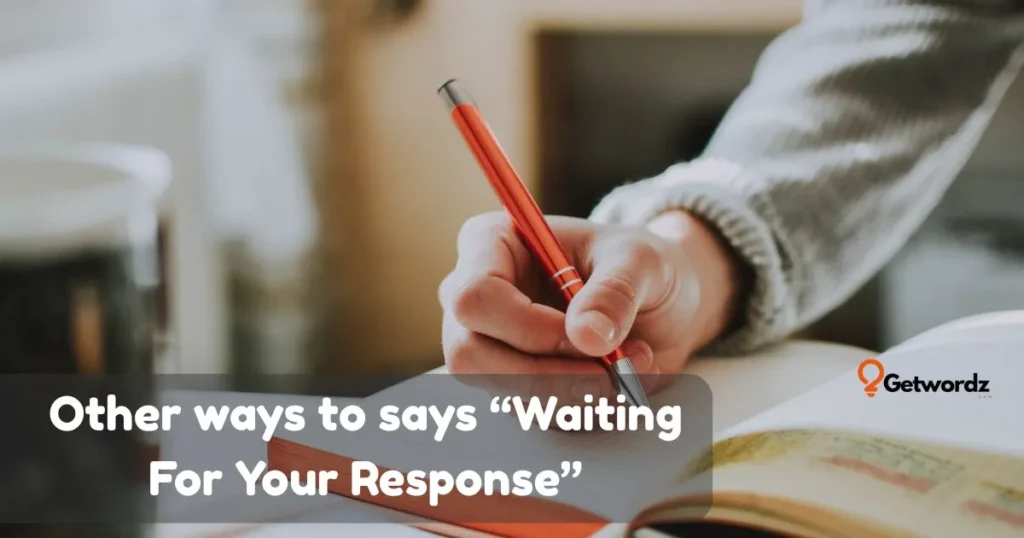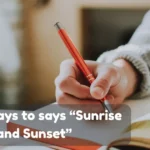Waiting for Your Response is one of those phrases we all use when we’re hoping to hear back from someone, whether it’s a text from a friend, an email to a client, or a message to your boss. It’s polite and clear, but let’s face it, hearing or typing it too often can make your message feel routine or even a little stiff.
If you’ve ever paused before hitting send, wondering how to say waiting for your response in a way that feels warmer, more personal, or simply different, you’re not alone. People everywhere are searching for better wording that keeps their tone friendly, confident, and professional.
From business emails and job applications to casual chats and follow-ups with loved ones, the right expression can completely change how your message is received.
In this post, you’ll find creative and meaningful alternatives to Waiting for Your Response that sound genuine and engaging in any situation. Get ready to explore phrases that help you connect more naturally and leave a lasting impression every time you communicate.
1. Looking Forward to Hearing from You
Scenario:
You’ve just sent a job application or proposal and want to sound hopeful yet professional. This phrase shows enthusiasm without pressure, making it perfect for business emails or polite follow-ups.
Explanation:
“Looking forward to hearing from you” is a warm, optimistic alternative to Waiting for Your Response. It keeps the tone professional, friendly, and confident, ideal for clients, recruiters, or colleagues. It’s a creative alternative that adds positive energy to your message.
Examples:
- I’m excited about this opportunity and looking forward to hearing from you soon.
- Thank you for your time, and I look forward to hearing from you regarding next steps.
- Your feedback means a lot, so I’m looking forward to hearing your thoughts.
Why It Works:
This phrase conveys optimism and engagement while keeping your tone respectful. It’s polished, easy to use in both formal and semi-casual messages, and helps your message end on a professional note.
2. Can’t Wait to Hear Back
Scenario:
When texting a close friend or partner, you want to sound more casual and emotionally open. This phrase expresses eagerness and excitement naturally.
Explanation:
“Can’t wait to hear back” is an informal, lively version of Waiting for Your Response. It’s great for personal communication, showing genuine anticipation. It’s a creative and friendly alternative that adds personality to your message.
Examples:
- I sent you the pictures, can’t wait to hear back!
- Just finished reading your message and can’t wait to hear what you think.
- Hope your day’s going great! Can’t wait to hear back from you.
Why It Works:
This version feels fresh, spontaneous, and authentic. It’s especially effective in texts and casual emails where warmth and excitement matter more than formality.
3. Eager to Hear Your Thoughts
Scenario:
After sharing an idea, draft, or proposal, you want to sound open and collaborative. This phrase invites discussion while remaining polite and confident.
Explanation:
“Eager to hear your thoughts” is a semi-formal expression that replaces Waiting for Your Response with curiosity and respect. It works beautifully in professional and creative contexts, signaling your interest in the recipient’s perspective.
Examples:
- I’ve attached the first draft and am eager to hear your thoughts.
- Your opinion always helps improve my work, I’m eager to hear your insights.
- I shared the concept earlier and am eager to hear what you think.
Why It Works:
It’s thoughtful and encourages dialogue. This phrase positions you as approachable and collaborative, strengthening relationships in both business and personal communication.
4. Awaiting Your Feedback
Scenario:
You’ve submitted a report, pitch, or project and need feedback from a client or team leader. You want to sound patient but professional.
Explanation:
“Awaiting your feedback” is a formal, concise way to express Waiting for Your Response. It signals that you’re ready for the next step while respecting the other person’s timeline.
Examples:
- I’ve completed the presentation and am awaiting your feedback.
- The design draft is attached, awaiting your feedback before moving forward.
- I appreciate your review and am awaiting your comments.
Why It Works:
This alternative is professional and respectful, making it ideal for corporate communication. It conveys readiness and accountability without sounding demanding.
5. Hoping to Hear from You Soon
Scenario:
You’ve sent an email to a recruiter or old friend, and you want to sound kind and genuine while expressing anticipation.
Explanation:
“Hoping to hear from you soon” is a polite and slightly emotional variation of Waiting for Your Response. It’s often used in both professional and personal contexts and carries a soft, caring tone.
Examples:
- I truly enjoyed our conversation and am hoping to hear from you soon.
- Thank you for considering my application, I’m hoping to hear from you soon.
- It’s been a while since we last talked. Hoping to hear from you soon!
Why It Works:
The word “hoping” adds emotional warmth and sincerity. It feels more human and less mechanical, making it one of the most versatile alternatives.
6. Excited to Get Your Reply
Scenario:
You’re messaging someone after sharing good news or a creative idea and want to keep the tone upbeat.
Explanation:
“Excited to get your reply” is a lighthearted, energetic version of Waiting for Your Response. It fits informal emails, friendly follow-ups, or social media messages.
Examples:
- Just sent over the proposal, excited to get your reply!
- Can’t wait to know what you think about this idea! Excited to get your reply.
- Thanks again for your time, excited to get your reply soon!
Why It Works:
It creates a positive impression by expressing enthusiasm. This alternative stands out for being emotionally engaging and easy to connect with.
7. Your Reply Will Mean a Lot
Scenario:
You’re reaching out to someone important and want to express that their response truly matters to you.
Explanation:
“Your reply will mean a lot” is a heartfelt way to replace Waiting for Your Response. It’s suitable for personal messages, gratitude notes, or emotional conversations.
Examples:
- I really value your opinion, your reply will mean a lot.
- Your reply will mean a lot as I finalize this decision.
- Thank you for always listening; your reply will mean so much to me.
Why It Works:
It emphasizes emotional sincerity, making the message more personal and meaningful. It turns a simple follow-up into a connection-building gesture.
8. Hoping to Connect Soon
Scenario:
You’ve sent a message to a colleague, potential client, or old friend, and want to express gentle anticipation for communication.
Explanation:
“Hoping to connect soon” feels friendly, inclusive, and professional. It’s a creative alternative to Waiting for Your Response that works well in networking or follow-up emails.
Examples:
- It was great chatting earlier, hoping to connect soon for next steps.
- Thanks for the introduction! Hoping to connect soon to discuss further.
- I really enjoyed our conversation. Hoping to connect soon again.
Why It Works:
It blends warmth and professionalism, helping you sound approachable while keeping a respectful tone. Perfect for building relationships.
9. Looking Forward to Your Feedback
Scenario:
You’ve completed a task, presentation, or creative piece and are anticipating feedback from your audience or team.
Explanation:
“Looking forward to your feedback” is a balanced and positive expression that replaces Waiting for Your Response. It’s one of the most used professional follow-ups that shows confidence and openness to improvement.
Examples:
- I’ve attached the document and look forward to your feedback.
- The demo is ready, looking forward to your thoughts and suggestions.
- Appreciate your review and look forward to your feedback soon.
Why It Works:
It shows eagerness and professionalism without sounding pushy. It’s ideal for formal communication where tone and respect are key.
Read More: Other Ways to Say “Sunrise and Sunset” With Examples!
10. Anxiously Awaiting Your Reply
Scenario:
You’re waiting on important news, maybe a job offer, a love confession, or a big decision. You want to sound emotional but still polite.
Explanation:
“Anxiously awaiting your reply” conveys genuine anticipation and emotional investment. It’s a unique expression that humanizes your tone, especially in personal or heartfelt messages.
Examples:
- I’ve been thinking about our conversation and am anxiously awaiting your reply.
- This project means a lot to me, I’m anxiously awaiting your thoughts.
- It’s been on my mind all day, anxiously awaiting your reply.
Why It Works:
It captures the feeling behind waiting, hope, curiosity, and care. This phrase resonates because it feels sincere and emotionally real.
1. Waiting to Hear Your Thoughts
Scenario:
You’ve shared an idea or design and want to show curiosity about the other person’s opinion. This phrase is ideal when you value feedback and want to keep the conversation open.
Explanation:
“Waiting to hear your thoughts” is a friendly, semi-formal alternative to Waiting for Your Response. It shows that you care about their perspective and are genuinely interested in their feedback.
Examples:
- I sent the outline earlier and am waiting to hear your thoughts.
- Your input always helps me refine things, waiting to hear your thoughts.
- Just finished the mock-up, waiting to hear your thoughts on it.
Why It Works:
It keeps communication balanced and approachable. The phrase sounds collaborative, encouraging others to engage with your message naturally.
12. Hoping to Hear Back Soon
Scenario:
You’ve followed up on a message or request and want to remind someone politely without sounding impatient.
Explanation:
“Hoping to hear back soon” is a gentle and polite version of Waiting for Your Response. It keeps your tone professional yet friendly, perfect for clients, managers, or acquaintances.
Examples:
- Just wanted to follow up, hoping to hear back soon.
- Thank you for considering my proposal; I’m hoping to hear back soon.
- Sent the final files yesterday, hoping to hear back soon about the revisions.
Why It Works:
It’s respectful and non-demanding, showing you value the other person’s time. The phrase maintains a patient but proactive tone.
13. Looking Forward to Your Reply
Scenario:
You’ve just sent a polite professional email and want to close it gracefully while anticipating a response.
Explanation:
“Looking forward to your reply” is a polished, professional expression. It’s a more direct alternative to Waiting for Your Response that still conveys respect and optimism.
Examples:
- Thank you for reviewing the document. Looking forward to your reply.
- I appreciate your time and look forward to your reply soon.
- Please let me know if you need any more details. Looking forward to your reply.
Why It Works:
It sounds confident, courteous, and efficient. This phrase helps keep the communication tone positive and professional.
14. Can’t Wait to Hear What You Think
Scenario:
You’ve shared creative work, exciting news, or an update with someone close and want to sound enthusiastic.
Explanation:
“Can’t wait to hear what you think” is a casual, expressive version of Waiting for Your Response. It works great in friendly or creative settings, showing genuine anticipation.
Examples:
- Just finished editing the video, can’t wait to hear what you think!
- Sent over the designs, can’t wait to hear what you think of them.
- I wrote a new piece today, can’t wait to hear what you think.
Why It Works:
It’s full of personality and excitement, making your message feel human and engaging. It’s perfect for messages that need warmth and creativity.
15. Eagerly Awaiting Your Response
Scenario:
You’ve sent an important message or application and want to sound polite but express eagerness clearly.
Explanation:
“Eagerly awaiting your response” is a formal yet emotional version of Waiting for Your Response. It conveys hope and respect, ideal for official correspondence.
Examples:
- I’ve submitted the proposal and am eagerly awaiting your response.
- Thank you for reviewing my application; I’m eagerly awaiting your reply.
- The meeting summary has been sent, eagerly awaiting your thoughts.
Why It Works:
It’s courteous and professional, showing enthusiasm without sounding desperate. It helps your communication feel sincere and serious.
16. Hope to Hear from You Soon
Scenario:
You’re wrapping up a friendly email or message and want to end with a hopeful note.
Explanation:
“Hope to hear from you soon” is one of the most universal and natural alternatives to Waiting for Your Response. It’s friendly, polite, and works across personal and professional contexts.
Examples:
- Thanks again for your help, hope to hear from you soon!
- I’d love to catch up. Hope to hear from you soon.
- Please let me know what you think. Hope to hear from you soon.
Why It Works:
It’s timeless, warm, and simple. It keeps your message open-ended and welcoming without any pressure.
17. Waiting for Your Feedback
Scenario:
You’ve sent a report, file, or creative draft and are waiting for comments or approval.
Explanation:
“Waiting for your feedback” is a straightforward, professional phrase that communicates readiness. It’s an excellent Waiting for Your Response alternative for workplace settings.
Examples:
- The presentation is attached, waiting for your feedback.
- I’d appreciate your review, waiting for your feedback before finalizing.
- Sent the concept yesterday and am waiting for your feedback.
Why It Works:
It’s concise and clear, keeping the focus on progress. This phrase reflects accountability and professionalism.
18. Eager to Hear Back from You
Scenario:
You’re anticipating a reply to something meaningful, like a collaboration, proposal, or conversation.
Explanation:
“Eager to hear back from you” is a versatile phrase that balances warmth and professionalism. It’s a more expressive alternative to Waiting for Your Response.
Examples:
- I’m eager to hear back from you regarding the next steps.
- Thanks again for your time, eager to hear back from you soon.
- Send the project outline, eager to hear back from you.
Why It Works:
It conveys positivity and genuine interest. It’s a go-to phrase that feels polished but still friendly.
19. I’ll Be Waiting for Your Reply
Scenario:
You’re closing a message where the response is essential for moving forward.
Explanation:
“I’ll be waiting for your reply” directly replaces Waiting for Your Response with a more conversational tone. It works well when you need acknowledgement or confirmation.
Examples:
- I’ve shared all the details, and I’ll be waiting for your reply.
- Please review the proposal, I’ll be waiting for your reply.
- I’ll be waiting for your reply so we can finalize the schedule.
Why It Works:
It’s clear, simple, and actionable. This phrase makes your intent visible without sounding demanding.
20. Waiting to Hear from You
Scenario:
You’ve sent an email or text and want to remind someone subtly that you’re expecting a response.
Explanation:
“Waiting to hear from you” is a neutral, timeless expression that’s perfect for both formal and casual contexts. It’s one of the most familiar yet effective Waiting for Your Response alternatives.
Examples:
- Just checking in, waiting to hear from you soon.
- The details are all shared, waiting to hear from you.
- I’m excited to move ahead, waiting to hear from you soon.
Why It Works:
It’s easy to use, widely understood, and maintains professionalism. It’s a dependable phrase for polite communication.
21. Looking Forward to Your Message
Scenario:
You’re expecting a reply by message or chat and want to keep the tone modern and friendly.
Explanation:
“Looking forward to your message” is a conversational twist on Waiting for Your Response. It suits digital communication and friendly professional exchanges.
Examples:
- Thanks for your time, looking forward to your message soon.
- I shared my thoughts, looking forward to your message.
- Excited to coordinate with you, looking forward to your message.
Why It Works:
It’s casual yet polite and works perfectly in email or chat-based communication. It keeps your tone approachable.
22. Hope to Get Your Reply Soon
Scenario:
You’re following up politely on something time-sensitive.
Explanation:
“Hope to get your reply soon” is a direct and caring variation of Waiting for Your Response. It’s professional but friendly enough for everyday messages.
Examples:
- Hope to get your reply soon so we can plan accordingly.
- Thank you for reviewing my submission; hope to get your reply soon.
- I shared the files earlier, hope to get your reply soon.
Why It Works:
It’s clear, polite, and to the point. This phrase helps you follow up without pressure while maintaining positivity.
Read More: 30 Other Ways To Say “It Was a Pleasure Meeting You”
23. Can’t Wait to Hear Your Reply
Scenario:
You’ve sent something exciting or personal and are eager to hear back.
Explanation:
“Can’t wait to hear your reply” is a lively, upbeat way to express anticipation. It’s a creative and emotional alternative to Waiting for Your Response.
Examples:
- I finally sent it, can’t wait to hear your reply!
- Your opinion always matters, can’t wait to hear your reply.
- Just sent the final draft, can’t wait to hear your reply.
Why It Works:
It conveys enthusiasm and real interest. This phrase makes communication feel more engaging and human.
24. Awaiting Your Kind Response
Scenario:
You’re sending a polite message to a client, manager, or senior and want to sound respectful.
Explanation:
“Awaiting your kind response” is a formal and courteous version of Waiting for Your Response. It’s ideal for professional emails or official letters.
Examples:
- I’ve attached the details and am awaiting your kind response.
- Thank you for your time; I’m awaiting your kind response soon.
- We value your opinion and are awaiting your kind response.
Why It Works:
It maintains dignity and professionalism, perfect for corporate and respectful communication.
25. Waiting to Hear from You Soon
Scenario:
You’ve sent an important email and want to keep the tone hopeful but professional.
Explanation:
“Waiting to hear from you soon” is one of the most balanced and adaptable alternatives to Waiting for Your Response.
Examples:
- I’ve sent over the project brief, waiting to hear from you soon.
- Thank you for reviewing, waiting to hear from you soon.
- The proposal has been shared, waiting to hear from you soon.
Why It Works:
It feels both polite and proactive. This phrase helps you express anticipation gracefully.
26. Hope to Receive Your Feedback
Scenario:
You’ve completed work and want a review or response from your client or teacher.
Explanation:
“Hope to receive your feedback” is a respectful, formal way to replace Waiting for Your Response. It’s ideal for structured communication.
Examples:
- The report is attached, hope to receive your feedback soon.
- I truly value your insights, and hope to receive your feedback.
- Please review when convenient, hope to receive your feedback soon.
Why It Works:
It demonstrates respect for the recipient’s time while inviting feedback naturally.
27. Awaiting Your Positive Response
Scenario:
You’re applying for a position, partnership, or proposal and want to show confidence in the outcome.
Explanation:
“Awaiting your positive response” expresses optimism and professionalism. It’s a confident alternative to Waiting for Your Response.
Examples:
- I’ve submitted my application and am awaiting your positive response.
- Thank you for reviewing my request, awaiting your positive response.
- I appreciate your consideration and am awaiting your positive response.
Why It Works:
It adds a hopeful tone without arrogance, showing faith in your communication and the recipient’s decision.
28. I’ll Be Glad to Hear from You
Scenario:
You’re reaching out warmly to a friend, colleague, or mentor.
Explanation:
“I’ll be glad to hear from you” is a friendly and welcoming way to express anticipation. It replaces Waiting for Your Response with sincerity and charm.
Examples:
- It’s been a while, I’ll be glad to hear from you soon.
- I’ll be glad to hear from you whenever you’re free.
- Your messages always brighten my day; I’ll be glad to hear from you.
Why It Works:
It sounds natural, kind, and emotionally engaging. It’s perfect for informal yet heartfelt communication.
29. Looking Forward to Continuing Our Conversation
Scenario:
You’ve had an engaging chat and want to leave the door open for more discussion.
Explanation:
“Looking forward to continuing our conversation” is a smart, warm alternative to Waiting for Your Response. It’s collaborative and works for both personal and professional exchanges.
Examples:
- I really enjoyed our discussion, looking forward to continuing our conversation.
- Your insights were inspiring; looking forward to continuing our conversation soon.
- It was great talking today, looking forward to continuing our conversation.
Why It Works:
It invites connection and engagement. The phrase feels interactive, not just expectant.
30. I’ll Wait for Your Update
Scenario:
You’re expecting a follow-up, decision, or confirmation from someone soon.
Explanation:
“I’ll wait for your update” is a calm, straightforward way to replace Waiting for Your Response. It’s respectful, practical, and suited to both business and casual messages.
Examples:
- No rush, I’ll wait for your update when you can.
- Thanks for checking with the team, I’ll wait for your update.
- I’ll wait for your update once the meeting’s done.
Why It Works:
It’s confident, clear, and easy to understand. It keeps your message patient while subtly prompting action.
✅ Pros and cons of Using “Waiting for Your Response”
pros
- Polite and professional tone: The phrase shows respect and patience, making it suitable for business emails or formal messages.
- Clear intention: It directly communicates that you expect a reply, leaving no confusion about your purpose.
- Universally understood: People from different backgrounds or cultures easily recognize what it means.
- Appropriate for multiple contexts: Works well in both professional and personal communication, from client follow-ups to friendly check-ins.
- Simple and efficient: It’s a short, straightforward expression that doesn’t require extra explanation or context.
⚠️ Cons
- Sounds overused: Because it’s so common, it can feel generic or impersonal in repeated use.
- May seem passive-aggressive: Depending on the tone or timing, it can come across as impatient or demanding.
- Lacks emotional warmth: It doesn’t convey friendliness or personality, especially in casual or heartfelt communication.
- Not ideal for creative writing: The phrase feels too standard and formal, which limits expression in personal messages or storytelling.
- Can reduce engagement: Over-reliance on this phrase might make your messages blend in rather than stand out.
Closing words
Waiting for Your Response often feels like the go-to phrase when you’re expecting a reply, but using it too often can make your messages sound predictable. This post shared fresh alternatives and creative expressions that help you communicate with warmth and originality. By exploring better wording, you can keep your tone polite yet engaging in every situation.
Whether you’re following up with a colleague, texting a friend, or sending a professional email, these unique expressions and different ways to say it help your messages feel more personal and confident. Try one of these phrases in your next message to make your communication stand out.
By choosing thoughtful, creative alternatives, you show authenticity and emotional intelligence. Let your next message shine with clarity and sincerity instead of the usual waiting for your response.




